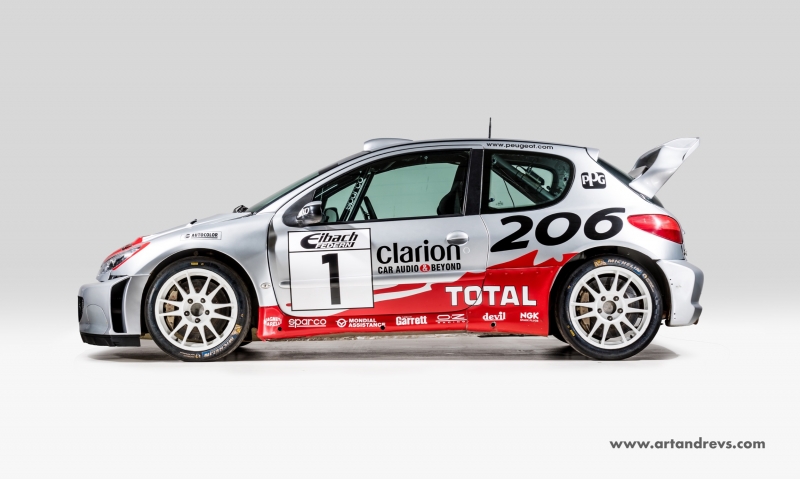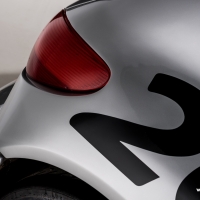PEUGEOT 206 WRC For sale
Chassis C31 - late specifications
Driven in WRC by Marcus Grönholm
Excellent condition and race ready
Description
This amazing 206 WRC, chassis number C31, was registered 206 NLN 75. It is a 2001 car originally and subsequently equipped with late specification components. It was built in asphalt configuration and only raced once with the factory in the hands of Marcus Grönholm at the 2001 ADAC Rally. Unfortunately a puncture plus a little mistake on Sunday deprived him of the podium but despite this he finished in a very creditable 4th place. It looks like very little was done to it before it was sold to highly reputable Bozian Racing in 2004 to compete in the 2004 WRC in the hands of Nicolas Vouilloz and Henning Solberg, Vouilloz driving all of the tarmac rounds.
It did another few rounds of WRC until 2007 before it passed through a couple of hands in France to compete in the FRC then more local rallies. C31 has been meticulously maintained all of its life, however after years of rallying it was decided in 2016 to have the car completely restored from the chassis up and the current owner brought it to SMG, a Philippe Gache company. The chassis was taken back to the bare metal, every panel inspected and replaced where necessary. The car went next to a private collector who had it looked after by the 206 WRC worldwide specialist Christophe Vaison.
The car is offered today fully serviced at Vaison Sport and in ready to race condition with important life left on the main mechanical components. C31 was last driven in June 2019 in testing and performed remarkably with all the systems checked by an ex. Peugeot Sport engineer. The car comes with an important spares package and it is hard to imagine a better prepared race ready 206 WRC in such excellent condition.
It also important to mention that the original FIA Gold pass still accompanies the car with VIN and WRC matching numbers.
The car's correct and complete racing history can be found here : https://www.ewrc-results.com/carinfo/6-peugeot-206-wrc/?car=366&a=1#start
Model history
After 14 years out of the lime light 1999 marked Peugeot’s return to WRC. The car’s genesis and the team set up was the key of its amazing success and legacy.
The marque’s efforts in Formula 1 was probably a wrong move and in 1997 it was decided to use the experience acquired with the 306 Maxi to build a rally car upon the all-new WRC regulations. To do so Jean Pierre Nicolas, Jean Todt’s former right hand man, recruited engineers of the highest calibre to re-inforce the Peugeot Sport team. The WRC regulations were pretty radical and these were times for a new philosophy in terms of engineering, opening up one of the most creative eras in Rallysport.
Nicolas managed to hire Michel Nandan who worked for Toyota on the Corolla WRC and he master minded the hydro-electronically controlled differentials which were an important key of the car’s performance. That’s to say the 206 WRC used a differential layout similar to that found in the Toyota Corolla WRC. In fact the lubrification is delivered by the same oil which is used in the engine, gearbox, differentials and power assisted steering. All the oil is collected in a single, multi-channel, water to oil heat exchanger for cooling and is then redistributed to the different mechanical parts from the same multi channel hydraulic central unit. The team of engineers also included to name but a few François Xavier Delfosse, Julien Loisy and Mario Fornaris. After the basic design had been completed in house at Peugeot Sport, Pipo was entrusted to develop and supply the engines. The regulations permitted a lot of changes and Peugeot opted for a longitudinal gearbox for better weight distribution to improve dynamics and create space. The shock absorbers were built by Peugeot, the only manufacturer to do so. The very sexy body was designed by Gerard Welter ( Peugeot’s head designer ) and Murat Gunak ( ex. Mercedes ).
During its life the 206 WRC evolved with a big step in 2001 when it received an all new engine with torque improving from 650NM to 850NM, the Xtrac gearbox went from 6 to 5 speeds and now ran on a different chassis setup.
Some of the top drivers back then were enrolled such as Auriol, Delecour, Panizzi and an unknown Finn : Marcus Grönholm. Grönholm’s driving style perfectly matched the car’s behavior. Indeed the Peugeot 206 WRC slides a lot less around corners than other WRC contenders and is, thus, less impressive to watch but far more efficient and fast than other cars that are driven with constant trajectory corrections. This behavior is due to the extreme care taken in the design of the car’s suspension and drivetrain and, apart from preserving the tires, has made the 206 WRC very hard to beat on any surface. A lot of Grönholm’s success is also to be credited to his development engineer, François Xavier Demaison who master minded and re designed the way the hydraulic differentials worked. He later became the technical director of VW Motorsport.
The car debuted at the Tour de Corse in 1999 just as the 205 Turbo 16 did 15 years earlier. It immediately displayed amazing pace and part way through the ’99 season, the Peugeot squad entered the complete 2000 championship. After a difficult start at the Monte Carlo, it was not long before the 206 gained success as Grönholm won in Sweden. Winning four rounds and podium finishes in two other rounds he won the WRC drivers’ Championship in the 206’s first attempt.
Between 2000 and 2002 Peugeot won 19 races, 3 manufacturers’ and 2 drivers’ championships, before a new generation of WRC cars appeared in 2003. Panizzi did remarkably well with the 206 and was given the nick name of « Tarmac Master », he was indeed pretty hard to beat on that surface.
The 206 WRC wrote some of the best pages in the WRC history, a time when the performance was the only aim, creativity was a reality and the cars looked beautiful. Since then it became one of the most Iconic rally cars ever, such as the Stratos, the Quattro or the 205 Turbo 16.




























